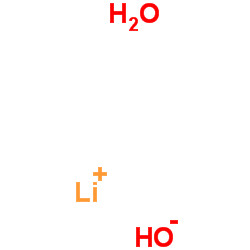Lithium hydroxide

Lithium hydroxide structure
|
Common Name | Lithium hydroxide | ||
|---|---|---|---|---|
| CAS Number | 1310-66-3 | Molecular Weight | 41.964 | |
| Density | 1.51 | Boiling Point | 920 °C | |
| Molecular Formula | H3LiO2 | Melting Point | 462 °C | |
| MSDS | Chinese USA | Flash Point | N/A | |
| Symbol |


GHS05, GHS07 |
Signal Word | Danger | |
|
Cell-free expression and in meso crystallisation of an integral membrane kinase for structure determination.
Cell. Mol. Life Sci. 71(24) , 4895-910, (2014) Membrane proteins are key elements in cell physiology and drug targeting, but getting a high-resolution structure by crystallographic means is still enormously challenging. Novel strategies are in big demand to facilitate the structure determination process t... |
|
|
Simple and robust monitoring of ethanol fermentations by capillary electrophoresis.
Biotechnol. Appl. Biochem. 62 , 329-42, (2015) Free-solution capillary electrophoresis (CE), or capillary zone electrophoresis, with direct UV detection was used for the first time for the determination of mono- and disaccharides, sugar alcohols, and ethanol in fermentation broths. Sample preparation prov... |
|
|
Generalized model of electromigration with 1:1 (analyte:selector) complexation stoichiometry: part II. Application to dual systems and experimental verification.
J. Chromatogr. A. 1384 , 147-54, (2015) Interactions among analyte forms that undergo simultaneous dissociation/protonation and complexation with multiple selectors take the shape of a highly interconnected multi-equilibrium scheme. This makes it difficult to express the effective mobility of the a... |
|
|
IFI44 suppresses HIV-1 LTR promoter activity and facilitates its latency.
Virology 481 , 142-50, (2015) IFI44 is an interferon-alfa inducible protein, and is associated with infection of several viruses. However, IFI44 elicits minimal antiviral effects on these viruses, and its exact role is still unknown. Here we show that IFI44 inhibits HIV-1 replication in v... |
|
|
Controlling the exciton energy of zinc oxide (ZnO) quantum dots by changing the confinement conditions.
Spectrochim. Acta. A. Mol. Biomol. Spectrosc. 152 , 637-44, (2015) ZnO nanoparticles were synthesized by solid state and hydrolysis methods based on the conventional precipitation. In situ growth of ZnO nanoparticles were monitored by photoluminescence spectroscopy (PL). By the help of electron paramagnetic resonance (EPR) t... |
|
|
High production of small organic dicarboxylate dianions by DESI and ESI.
J. Am. Soc. Mass Spectrom. 26(3) , 386-9, (2015) A significant production of gas-phase dicarboxylate dianions has been observed in standard ESI and DESI during the analysis of small organic dicarboxylic acids under moderate or highly alkaline conditions. In ESI, this can be attributed to an excess of hydrox... |
|
|
Determination of thermodynamic values of acidic dissociation constants and complexation constants of profens and their utilization for optimization of separation conditions by Simul 5 Complex.
J. Chromatogr. A. 1364 , 276-88, (2014) In this paper we determine acid dissociation constants, limiting ionic mobilities, complexation constants with β-cyclodextrin or heptakis(2,3,6-tri-O-methyl)-β-cyclodextrin, and mobilities of resulting complexes of profens, using capillary zone electrophoresi... |
|
|
Infrared spectroscopy of the Li+(H2O)Ar complex: the role of internal energy and its dependence on ion preparation.
Phys. Chem. Chem. Phys. 8(26) , 3078-82, (2006) The internal energy or effective temperature of cluster ions has become an important issue in characterizing the structures observed in these species. This report considers the role played by the method of ion preparation (laser vaporization-supersonic expans... |
|
|
Hydrogen-bond-induced inclusion complex in aqueous cellulose/LiOH/urea solution at low temperature.
ChemPhysChem 8(10) , 1572-9, (2007) It was puzzling that cellulose could be dissolved rapidly in 4.6 wt % LiOH/15 wt % urea aqueous solution precooled to -12 degrees C, whereas it could not be dissolved in the same solvent without prior cooling. To clarify this important phenomenon, the structu... |
|
|
Gas phase chemistry of Li+ with amides: the observation of LiOH loss in mass spectrometry.
J. Am. Soc. Mass Spectrom. 23(7) , 1191-201, (2012) Collision-induced dissociation (CID) of Li(+) adducts of three sets of compounds that contains an amide bond, including 2-(4, 6-dimethoxypyrimidin-2-ylsulfanyl)-N-phenylbenzamide, its derivatives and simpler structures was investigated by electrospray ionizat... |